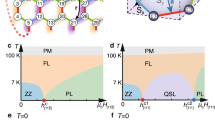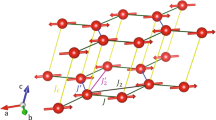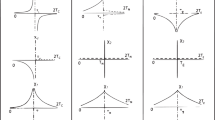Abstract
In RuCl3, inelastic neutron scattering and Raman spectroscopy reveal a continuum of non-spin-wave excitations that persists to high temperature, suggesting the presence of a spin liquid state on a honeycomb lattice. In the context of the Kitaev model, finite magnetic fields introduce interactions between the elementary excitations, and thus the effects of high magnetic fields that are comparable to the spin-exchange energy scale must be explored. Here, we report measurements of the magnetotropic coefficient—the thermodynamic coefficient associated with magnetic anisotropy—over a wide range of magnetic fields and temperatures. We find that magnetic field and temperature compete to determine the magnetic response in a way that is independent of the large intrinsic exchange-interaction energy. This emergent scale-invariant magnetic anisotropy provides evidence for a high degree of exchange frustration that favours the formation of a spin liquid state in RuCl3.
This is a preview of subscription content, access via your institution
Access options
Access Nature and 54 other Nature Portfolio journals
Get Nature+, our best-value online-access subscription
$29.99 / 30 days
cancel any time
Subscribe to this journal
Receive 12 print issues and online access
$209.00 per year
only $17.42 per issue
Buy this article
- Purchase on Springer Link
- Instant access to full article PDF
Prices may be subject to local taxes which are calculated during checkout




Similar content being viewed by others
Data availability
All data that support the plots within this paper and other findings of this study are available from the corresponding author upon reasonable request.
References
Kitaev, A. Anyons in an exactly solved model and beyond. Ann. Phys. 321, 2–111 (2006).
Kasahara, Y. et al. Unusual thermal Hall effect in a Kitaev spin liquid candidate α-RuCl3. Phys. Rev. Lett. 120, 217205 (2018).
Kasahara, Y. et al. Majorana quantization and half-integer thermal quantum Hall effect in a Kitaev spin liquid. Nature 559, 227–231 (2018).
Sears, J. A., Zhao, Y., Xu, Z., Lynn, J. W. & Kim, Y.-J. Phase diagram of α-RuCl3 in an in-plane magnetic field. Phys. Rev. B 95, 180411 (2017).
Wolter, A. U. B. et al. Field-induced quantum criticality in the Kitaev system α-RuCl3. Phys. Rev. B 96, 041405 (2017).
Sandilands, L. J., Tian, Y., Plumb, K. W., Kim, Y.-J. & Burch, K. S. Scattering continuum and possible fractionalized excitations in α-RuCl3. Phys. Rev. Lett. 114, 147201 (2015).
Banerjee, A. et al. Proximate Kitaev quantum spin liquid behaviour in a honeycomb magnet. Nat. Mater. 15, 733–740 (2016).
Banerjee, A. et al. Neutron scattering in the proximate quantum spin liquid α-RuCl3. Science 356, 1055–1059 (2017).
Baek, S.-H. et al. Evidence for a field-induced quantum spin liquid in α-RuCl3. Phys. Rev. Lett. 119, 037201 (2017).
Wang, Z. et al. Magnetic excitations and continuum of a possibly field-induced quantum spin liquid in α-RuCl3. Phys. Rev. Lett. 119, 227202 (2017).
Ponomaryov, A. N. et al. Unconventional spin dynamics in the honeycomb-lattice material α-RuCl3: high-field electron spin resonance studies. Phys. Rev. B 96, 241107 (2017).
Jackeli, G. & Khaliullin, G. Mott insulators in the strong spin–orbit coupling limit: from Heisenberg to a quantum compass and Kitaev models. Phys. Rev. Lett. 102, 017205 (2009).
Savary, L. & Balents, L. Quantum spin liquids: a review. Rep. Prog. Phys. 80, 016502 (2016).
Modic, K. A. et al. Realization of a three-dimensional spin-anisotropic harmonic honeycomb iridate. Nat. Commun. 5, 4203 (2014).
Chun, S. H. et al. Direct evidence for dominant bond-directional interactions in a honeycomb lattice iridate Na2IrO3. Nat. Phys. 11, 462–466 (2015).
Majumder, M. et al. Anisotropic Ru3+ 4d5 magnetism in the α-RuCl3 honeycomb system: susceptibility, specific heat, and zero-field NMR. Phys. Rev. B 91, 180401 (2015).
Kimchi, I., Analytis, J. G. & Vishwanath, A. Three-dimensional quantum spin liquids in models of harmonic-honeycomb iridates and phase diagram in an infinite-D approximation. Phys. Rev. B 90, 205126 (2014).
Chaloupka, J., Jackeli, G. & Khaliullin, G. Zigzag magnetic order in the iridium oxide Na2IrO3. Phys. Rev. Lett. 110, 097204 (2013).
Das, S. D. et al. Magnetic anisotropy of the alkali iridate Na2IrO3 at high magnetic fields: evidence for strong ferromagnetic Kitaev correlations. Phys. Rev. B 99, 081101 (2019).
Johnson, R. D. et al. Monoclinic crystal structure of α-RuCl3 and the zigzag antiferromagnetic ground state. Phys. Rev. B 92, 235119 (2015).
Kubota, Y., Tanaka, H., Ono, T., Narumi, Y. & Kindo, K. Successive magnetic phase transitions in α-RuCl3: XY-like frustrated magnet on the honeycomb lattice. Phys. Rev. B 91, 094422 (2015).
Cao, H. B. et al. Low-temperature crystal and magnetic structure of α-RuCl3. Phys. Rev. B 93, 134423 (2016).
Modic, K. A. et al. Robust spin correlations at high magnetic fields in the harmonic honeycomb iridates. Nat. Commun. 8, 180 (2017).
Leahy, I. A. et al. Anomalous thermal conductivity and magnetic torque response in the honeycomb magnet α-RuCl3. Phys. Rev. Lett. 118, 187203 (2017).
Yoshitake, J., Nasu, J., Kato, Y. & Motome, Y. Majorana–magnon crossover by a magnetic field in the Kitaev model: continuous-time quantum Monte Carlo study. Phys. Rev. B 101, 100408 (2020).
Gordon, J. S., Catuneanu, A., Sørensen, E. S. & Kee, H.-Y. Theory of the field-revealed Kitaev spin liquid. Nat. Commun. 10, 2470 (2019).
Zheng, J. et al. Gapless spin excitations in the field-induced quantum spin liquid phase of α-RuCl3. Phys. Rev. Lett. 119, 227208 (2017).
Gammel, P. L., Schneemeyer, L. F., Wasczak, J. V. & Bishop, D. J. Evidence from mechanical measurements for flux-lattice melting in single-crystal YBa2Cu3O7 and Bi2.2Sr2Ca0.8Cu2O8. Phys. Rev. Lett. 61, 1666 (1988).
Kleiman, R. N., Kaminsky, G. K., Reppy, J. D., Pindak, R. & Bishop, D. J. Single-crystal silicon high-Q torsional oscillators. Rev. Sci. Instrum. 56, 2088 (1985).
Modic, K. A. et al. Resonant torsion magnetometry in anisotropic quantum materials. Nat. Commun. 9, 3975 (2018).
Callen, H. B. Thermodynamics and an Introduction to Thermostatics (Wiley, 1985).
Riedl, K., Li, Y., Winter, S. M. & Valentí, R. Sawtooth torque in anisotropic Jeff = 1/2 magnets: application to α-RuCl3. Phys. Rev. Lett. 122, 197202 (2019).
Blundell, S. Magnetism in Condensed Matter (Oxford Univ. Press, 2000).
Anderson, P. W. Resonating valence bonds: a new kind of insulator? Mater. Res. Bull. 8, 153–160 (1973).
Acknowledgements
We thank M. Baenitz, A. Bangura, R. Coldea, G. Jackeli, S. Kivelson, S. Nagler, R. Valenti, C. Varma, S. Winter and J. Zaanen for insightful discussions. Samples were grown at the Max Planck Institute for Chemical Physics of Solids. The d.c.-field measurements were made at the National High Magnetic Field Laboratory (NHMFL) in Tallahassee, FL. The pulsed-field measurements were made in the Pulsed Field Facility of the NHMFL in Los Alamos, NM. All work at the NHMFL is supported through the National Science Foundation Cooperative Agreement nos. DMR-1157490 and DMR-1644779, the US Department of Energy and the State of Florida. R.D.M. acknowledges support from LANL LDRD-DR 20160085 Topology and Strong Correlations. M.C. acknowledges support from the Department of Energy ‘Science of 100 tesla’ BES programme for high-field experiments. X-ray data acquisition and analysis was performed at Cornell University. Research conducted at the Cornell High Energy Synchrotron Source (CHESS) is supported by the National Science Foundation under award no. DMR-1332208. B.J.R. acknowledges support from the Institute for Quantum Matter, an Energy Frontier Research Center funded by the US Department of Energy, Office of Science, Office of Basic Energy Sciences under award no. DE-SC0019331. Y.L. acknowledges support from the US Department of Energy through the LANL/LDRD programme and the G.T. Seaborg institute. J.C.P. is supported by a Gabilan Stanford Graduate Fellowship and an NSF Graduate Research Fellowship (grant no. DGE-114747). P.J.W.M. acknowledges funding from the Swiss National Science Foundation through project no. PP00P2-176789.
Author information
Authors and Affiliations
Contributions
K.A.M., R.D.M., B.J.R. and A.S. conceived the experiment. M.S. grew the samples. J.P.C.R., B.J.R. and D.A.S. performed X-ray characterization. K.A.M., R.D.M., M.D.B., Y.L., J.C.P., D.G., M.C., F.F.B., J.B.B. and A.S. performed the measurements. K.A.M., R.D.M, M.J.L., P.J.W.M., B.J.R. and A.S. analysed data and performed simulations. K.A.M., R.D.M., G.S.B., B.J.R. and A.S. wrote the manuscript with contributions from all authors.
Corresponding author
Ethics declarations
Competing interests
The authors declare no competing interests.
Additional information
Peer review information
Nature Physics thanks Arnab Banerjee, Martin Klanjsek and the other, anonymous, reviewer(s) for their contribution to the peer review of this work.
Publisher’s note Springer Nature remains neutral with regard to jurisdictional claims in published maps and institutional affiliations.
Supplementary information
Supplementary Information
Supplementary text, Figs. 1–15 and references.
Rights and permissions
About this article
Cite this article
Modic, K.A., McDonald, R.D., Ruff, J.P.C. et al. Scale-invariant magnetic anisotropy in RuCl3 at high magnetic fields. Nat. Phys. 17, 240–244 (2021). https://doi.org/10.1038/s41567-020-1028-0
Received:
Accepted:
Published:
Issue Date:
DOI: https://doi.org/10.1038/s41567-020-1028-0
This article is cited by
-
Possible intermediate quantum spin liquid phase in α-RuCl3 under high magnetic fields up to 100 T
Nature Communications (2023)
-
Magnetic anisotropy reversal driven by structural symmetry-breaking in monolayer α-RuCl3
Nature Materials (2023)
-
A magnetic continuum in the cobalt-based honeycomb magnet BaCo2(AsO4)2
Nature Materials (2023)
-
Spin supersolidity in nearly ideal easy-axis triangular quantum antiferromagnet Na2BaCo(PO4)2
npj Quantum Materials (2022)
-
Anomalous and anisotropic nonlinear susceptibility in the proximate Kitaev magnet α-RuCl3
npj Quantum Materials (2021)



